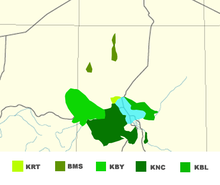Kanuri language
| Kanuri | |
|---|---|
| Native to | Nigeria, Niger, Chad, Cameroon |
| Region | Lake Chad |
| Ethnicity | Kanuri (Yerwa Kanuri etc.), Kanembu |
|
Native speakers
|
(4.2 million cited 1985–2006) |
|
Nilo-Saharan?
|
|
| Language codes | |
| ISO 639-1 | kr |
| ISO 639-2 | |
| ISO 639-3 |
Individual codes: knc – Central Kanuri kby – Manga Kanuri krt – Tumari Kanuri bms – Bilma Kanuri kbl – Kanembu |
| Glottolog | kanu1279 |
| Linguasphere | 02-AAA-a (+Kanembu 02-AAA-b) |

Map of the majority usage of the five major languages of the Kanuri language group.
|
|
Kanuri /kəˈnuːri/ is a dialect continuum spoken by some four million people, as of 1987, in Nigeria, Niger, Chad and Cameroon, as well as small minorities in southern Libya and by a diaspora in Sudan. It belongs to the Western Saharan subphylum of Nilo-Saharan. Kanuri is the language associated with the Kanem and Bornu empires which dominated the Lake Chad region for a thousand years.
The basic word order of Kanuri sentences is subject–object–verb. It is typologically unusual in simultaneously having postpositions and post-nominal modifiers – for example, "Bintu's pot" would be expressed as nje Bintu-be, "pot Bintu-of".
Kanuri has three tones: high, low, and falling. It has an extensive system of consonant weakening (for example, sa- "they" + -buma "have eaten" → za-wuna "they have eaten".
Traditionally a local lingua franca, its usage has declined in recent decades. Most first-language speakers speak Hausa or Arabic as a second language.
Kanuri is spoken mainly in lowlands of the Lake Chad basin, with speakers in Cameroon, Chad, Niger, Nigeria and Sudan.
...
Wikipedia
